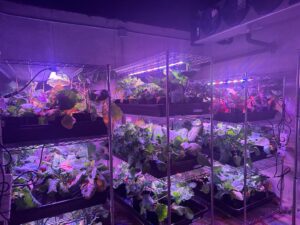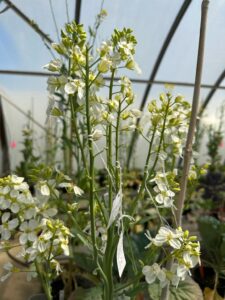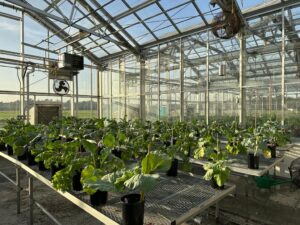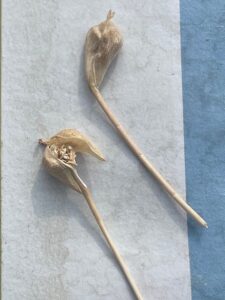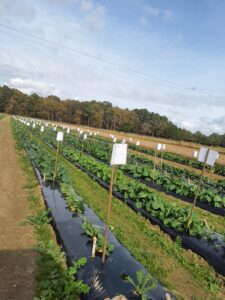Final report for GS22-263
Project Information
Collard greens are primarily produced in the Southern region where they are an important cultural heritage crop. Brassica oleracea leafy greens, including collard greens and kale, are an exceptional source of vitamins, minerals, and phenolic compounds. However, research on these crops is limited leading to reduced availability and use of genetic resources for Brassica leafy greens. Despite the increasing popularity of collard greens and kale, the number of cultivars available for their production remains low. In addition, production is challenged by high insect and disease pressure, and the emergence of new pathogenic strains of economically important diseases (Bacterial leaf blight, Alternaria leaf spot) emphasizing the need for improved cultivars. We propose to develop a B. oleracea leafy green diversity panel from public germplasm sources, including the USDA-NPGS collection and the Seed Savers Exchange (SSE). The developed diversity panel, BLG1, would be a valuable source of alleles for improved nutrition (high glucosinolates), biotic (diseases and pests) and abiotic (salinity and high temperature) stress resistance for B. oleracea breeding programs. Release of new, improved cultivars would increase sustainability and profitability of Brassica leafy greens production through reduction of pesticide usage combined with increased yields.
The main goal of this project is to develop a collection of B. oleracea leafy green accessions (collected from USDA-NPGS and the Seed Savers Exchange) to identify desirable alleles and facilitate their introgression into improved collard and kale cultivars for production in the Southeastern US. The transition of these accessions into more stable, homozygous lines will improve their utility for future breeding and genetics research projects. The long-term goals of these projects are to (i) genotype the diversity panel (BLG1) and map the genomic regions associated with biotic and abiotic stress resistance, and nutrition using genome-wide association studies (GWAS); (ii) develop new B. oleracea-leafy green cultivars with better horticultural traits and resistance; (iii) introgression of desirable alleles from these accessions to other economically important B. oleracea species like cabbage.
We have already self-pollinated 260 accessions (S0) once and have S1 seeds for each accession. Keeping this in mind our major objective will be to purify these accessions for one more season to obtain S2 seeds. Towards the fall 2023, phenotyping of each BLG1 individual will be done for different horticultural traits and the records will be maintained.
The proposed proposal has been formulated for these objectives:
Objective 1: Self-pollination and seed increase of the collected accessions during the first year, 2022-23
In fall 2022, single seeds of each accession (S1) will be sown to obtain S2 seeds for phenotyping to reduce segregation (i.e., to generate ‘true breeding’ seed) within each accession. Manual pollination will be carried out to ensure selfing for all 260 accessions of the diversity panel. This will be done in greenhouses available at Clemson University Coastal Research and Education Center (CREC) in Charleston, SC.
Objective 2: Phenotypic evaluation of all the S2 genotypes for different horticultural traits and disease resistance during the second year, 2023-24
Two replications of 10 seeds for each S2 accession will be seeded for field trials in Fall 2023 and Spring 2024 to evaluate the morphological diversity of all the accessions (collard, kale and non-heading cabbage), including leaf shape, leaf texture, leaf color, days to bolting and days to flowering. In addition to the field trials, the S2 kale genotypes will be screened for resistance against Alternaria leaf spot (Alternaria sp.). Alternaria leaf spot is the most important fungus on organic kale in South Carolina esp. in fall and the cultivars ‘Darkibor’ and ‘Winterbor’ are susceptible to the new causal agent, A. japonica (Keinath et al. 2021). The kale accessions in BLG1 (N=50) will expand the germplasm available for disease screening increasing the likelihood of identifying resistance sources.
Research
Objective 1
Self-pollination and seed increase of the collected accessions during the first year, 2022-23
A total of 283 Brassica oleracea accessions were collected, 238 accessions from the USDA NPGS and 45 accessions were obtained from the Seed Savers Exchange (SSE). These included 132 collard accessions (B. oleracea var. viridis); 15 curly kale accessions (Brassica oleracea var. sabellica); one lacinato kale accession (B. oleracea var. palmifolia); 12 Portuguese kale accessions (B. oleracea var. costata); 28 cauliflower (B. oleracea var. botrytis) accessions; one B. oleracea oleracea accession; and 60 non-heading cabbages (B. oleracea var. capitata) accessions. One collard accession was provided by our colleague at Coastal Research and Education Center, Charleston, SC. Additionally, collard hybrids, ‘Top Bunch’, ‘Top Bunch 2.0’, ‘Flash’, and varieties, ‘Top Chop’, ‘Champion’, ‘Alabama Blue’, ‘Georgia South’, ‘Georgia Green’ and ‘Jerry Hope’ were included. For kale, cultivars including, ‘Lacinato’, ‘Darkibor, ‘Siberian Dwarf’, ‘Toscano’, ‘Black Magic’, ‘Russian Royale’, and ‘Squire Kale’ were included. These cultivars were used as controls to evaluate the accessions for important horticultural traits. For accurate classification of these closely related species, UPOV guidelines for Distinctiveness, Uniformity and Stability (DUS) and USDA collard descriptors were followed.
From 2022 and 2023, one plant per accession (S0) were sown for manual pollination. Individual S0 plants for each accession were grown until 8 true leaves and then moved to vernalization chamber at 4°C, 5 hr daylight for 9 weeks. After vernalization, plants were moved to a greenhouse and maintained at 72°F and pollinated manually. As any other Brassica oleracea, self-incompatibility (sporophtyic) was expected in some accessions and bud-pollination was done to develop advanced generations.
Objective 2
Phenotypic evaluation of all the S2 genotypes for different horticultural traits and disease resistance during the second year, 2023-24
In Fall 2023 and Spring 2024, the S2 accessions were planted in a randomized complete block design (RCBD) with 168 plants per accession with two replications. Heading type cabbages were identified 40-52 days after transplanting (DAT) and removed from the panel. The horticultural traits important for stakeholders and growers including leaf color, leaf shape, leaf margin, leaf division, leaf incision, plant growth habit, glossy/non-glossy, leaf variegation, leaf blistering and fresh weight (kg) were recorded for six plants per plot leaving one plant at either side of the plot. Plant uniformity was evaluated on a plot basis where all plants in a plot were characterized based on leaf color, leaf shape, plant size and growth habit. Plant growth habit and petiole angle to the horizontal were recorded on plot basis, unless the plot was not uniform. For rest of the traits, individual plant observations were taken. The trait classes were tailored to the diversity present in the diversity panel. The UPOV kale guidelines for DUS and USDA collard descriptors were modified to form appropriate classes for leaf color and growth habit. The trait classes and appropriate scores for all traits are classified in Table 1. For fresh weight, six plants per plot were cut from base at 55-65 DAT, while keeping the length of largest leaves of the plants between 25 to 30 centimeters and the fresh weight (fw) in kilograms was recorded.
The data for 73 collard accessions including leaf width, height to apex, height to extremity, petiole length, days to first flower, days to fifty percent flowers, petiole thickness, leaf angle, cold damage, L*a*b* color was used for GWAS. The experiment was conducted in a RCBD with two replications (15 plants per rep) by Zachary Stansell and Mark Farnham in South Carolina in 2010. This data set is publicly available at the USDA GRIN website (https://www.ars-grin.gov/Collections#plant-germplasm). From the raw dataset, best linear unbiased estimators (BLUEs) were calculated to reduce environmental variation between replications for GWAS analysis. To determine the color of collard accessions, Konica Minolta Chroma Meter (Konica Minolta Americas, NJ) and the CIE L*a*b* color software (CM-S100w SpectraMagic NX) was used. For accurate readings, three leaves per accession were taken and the average was used for further analysis.
Statistical analysis
Heterogeneity of variances between different seasons was determined with Levene’s test (Levene 1960) in the car package (Fox and Weisberg 2011). Each season was analyzed separately due to significant differences in the variance between the two seasons for different traits (p value <2.07x10-13). For fresh weight, agricolae package in R (R Core Team 2022) was used to fit general linear regression models and the aov function (Chambers et al. 1992) was used to conduct Analyses of variance (ANOVA). The model consisted of accessions as fixed effect and the two replications as random effects. Fisher’s protected least significant difference (LSD, α= 0.05) was used to separate the accession means using the agricolae package (Mendiburu 2016). Pearson’s correlation for was also calculated between the two seasons.
Table 1
|
Sr. no. |
Trait code |
Trait |
Trait classes |
|
1 |
GP |
Position of growing point |
Lower part (1), Lower to middle part (2), Middle part (3), Middle to upper part (4), Upper part (5) |
|
2 |
PetA |
Angle of petiole with horizontal |
Erect (1), Open (2), Semi prostrate (3), Prostrate (4), Horizontal (5), Oblique (6) |
|
3 |
Unf |
Plant uniformity |
High degree of uniformity among plants (1), Mostly uniform plants with slight variation (2), Significant variation at least among a few of the plants (3), High degree of variation among the plants (4), Extreme variation among plants with no two plants alike in a plot (5) |
|
4 |
LfC |
Leaf color |
Yellow green (1), Light green (2), Green (3), Dark green (4), Blue green (5), Purple green (6), Purple (7), Grey green (8) |
|
5 |
G/NG |
Glossy (collards) |
Glossy (0), Non-glossy (1) |
|
6 |
LfM |
Leaf division margin |
Entire (0), Crenate (1), Dentate (2), Serrate (3), Undulate (4), Doubly dentate (5) |
|
7 |
LfI |
Leaf division incision |
Entire (1), Sinuate (2), Lyrate (3), Lacerate (4) |
|
8 |
LfS |
Leaf blade shape |
Orbicular (1), Elliptic (2), Obovate (3), Spathulate (4), Ovate (5), Lanceolate (6), Oblong (7) |
|
9 |
LfV |
Leaf blade variegation |
Absent (1), Present (9) |
|
10 |
LfB |
Leaf blade blistering |
Absent or very weak (1), Weak (3), Medium (5), Strong (7) |
Traits used for morphological characterization of the leafy B. oleracea accessions
Please note that we were not able to continue with eighteen accessions as no more seed is available from USDA-NPGS.
Comparison between seasons
Overall, the results from both seasons were comparable for the morphological traits. Highest variation between the two seasons was observed for fresh weight (fw), while leaf variegation which is a qualitative trait exhibited lowest variation between seasons. Significant differences between variances of the two seasons wereas observed for fresh weight, leaf color and leaf incision. Due to a reduced availability of seeds for certain accessions, the number of accessions evaluated during the spring season (N=225) was lower than the initial 263 accessions in the fall season. The overall frequency distribution of qualitative and pseudo-qualitative traits is detailed in Table 2.
Growth habit
The growth habit was determined on basis of two characteristics: i) position of growing point, and ii) angle of petiole with horizontal. A plant with 1 to 2 rating on scale for angle of petiole with horizontal and 3 to 5 on growing point scale was considered optimal for growth habit. Eighty accessions had an open angle of petiole with horizontal, while only five accessions had an erect angle. Six accessions had a middle to upper part growing point, and twelve accessions had an upper part growing point. Majority of the accessions were found to have a middle part growing point. The growth habit did not differ significantly between growing seasons (fall and spring season) and replications.
Uniformity
Out of 263, 233 accessions were found to have high degree of uniformity among the plants within the plot. However, seventeen accessions exhibited mostly uniform plants with slight degree of variation within the plot, score 2 and twelve accessions exhibited significant variation of few plants, score 3. These variations were mostly from different leaf shape, leaf blistering and leaf color within the plot. Only one kale accession (SSE #111213) had extreme variation with no two plants alike, score 5. This accession wasn’t self-pollinated, and S0 seed was used for phenotyping.
Leaf blistering
Among kale accessions, strongest leaf blistering was observed in SSE accessions 111123, 111186, 111188, 133549, and GRIN accession G30714. One cauliflower accession, PI 183213, and one cabbage accession PI 172751 had strong leaf blistering. Other accessions had weak to medium blistering, with an average blistering score from absent (1) to strong (7) for kale accessions, absent (1) to medium (5) for collard accessions, weak (3) to strong (7) blistering for both cabbage accessions and cauliflower accessions. For B. oleracea var. oleracea (G 30186), the average leaf blistering was weak (3). Leaf variegation was only observed in three kale accessions (PI 662661, SSE #111205, SSE #111251), while it was absent in all other accessions.
Glossy trait
Glossy mutants are common in multiple Brassica species, and it can be controlled by recessive and dominant genes in different species. All accessions were checked for glossy trait (especially cabbages and collards). Since no other accessions in the study expect collards had glossy trait, individual collard plants were examined for glossy/non-glossy trait. During fall 2023, glossy trait was observed in six collard accessions: PI 662579, PI 662806, PI 662828, PI 687117, SSE # 107838, SSE # 106776. For both replications, SSE # 107838, SSE # 106776, PI 687117, and PI 662828 segregated for glossy trait, while PI 662579and PI 662806 were all glossy. During spring 2024, same accessions were found to be glossy, but lesser segregation for glossy trait was observed.
Leaf blade shape in outline
During fall season, 127 accessions had an elliptic blade shape, followed by 94 accessions with orbicular leaf shape. Meanwhile, twenty-seven accessions had ovate leaf shape, ten accessions obovate and five accessions had spathulate leaf blade shape. The spathulate leaf shape was only observed in kale accessions. During spring season, 106 accessions had elliptic blade shape, followed by 88 accessions with orbicular leaf shape. Eighteen accessions were observed with ovate leaf shape and eight accessions with obovate leaf shape. The spathulate leaf shape was only observed in five kale accessions. Collard accesisons, PI 662838, PI 687133 and PI 204563 exhibited an orbicular to elliptic leaf shape while, SSE # 107833 and PI 171531 exhibited elliptic to ovate leaf shape. Cabbage accessions PI 171532 and PI 204681 exhibited an orbicular to elliptic leaf shape. Kale accession G 30862 had an elliptic to ovate leaf shape, while PI 343675 exhibited elliptic to obovate leaf shape and SSE # 133549 varied from elliptic to spathulate leaf shape
Leaf incision and margin
During fall season only fourteen accessions had varied leaf incision among the twelve plants, while during spring season 37 accessions had varied leaf incision among the plants. Among all accessions, lacerate leaf incision was only observed in two collards accessions, PI 687135 and PI 687136. Lyrate leaves were only in observed in one collard accession, PI 662828 and few kale accessions. The number of kale accessions with lyrate leaves was nineteen in fall and twelve in spring. Rest of the accessions had entire to sinuate leaf incisions. Among all accessions the leaf margin varied from entire to undulate. During both fall and spring seasons, kale accessions had undulate margins, while all other accessions had entire to crenate margins.
Fresh weight
The fresh weight was recorded on the plot basis with two replications of six plants per accession in each plot. The fresh weight for spring season was significantly higher than the fall season and the correlation between both seasons was low (r2=0.21). The range of fresh weight for fall season was from 0.41 to 5.87 kg, while for spring it varied from 0.88 to 10.12 kg. During fall, one replication had significantly smaller plant size due to lower soil level leading to more water accumulation. The highest yielding cultivar in the fall season was the collard green cultivar, 'Hi-Crop' at 4.11 kg. Hi-Crop had a significantly higher fresh weight than all other commercial cultivars evaluated. None of the accessions produced significantly more than Hi-Crop in the fall. Eleven accessions had significantly higher fresh weights (4.99 to 5.87 kg) in the fall than the commercial standard for the regions, 'Top Bunch 2.0' (3.46 kg). In the spring trial, three commercial cultivars had the significantly highest fresh weight, including 'Top Bunch 2.0' (10.06 kg), 'Flash' (7.98 kg) and 'Hi-Crop' (7.46 kg). None of the accessions produced significantly more leaf tissue than these cultivars.
In conclusion, none of the accessions outperformed the commercially available collard cultivars in terms of horticultural characteristics such as yield, desired leaf shape and color. However, as noted by several growers during the field day, they are a source of unique leaf characteristics that may be desirable for specialty markets such as frilly or purple leaves. Seed increases were time consuming and challenging due to the self-incompatibility of most Brassica oleracea accesssions. During the generation of S2 seed, many of the hand-pollinations would form a silique but upon harvest it was filled with vegetative tissue instead of seeds. Due to these seed limitations, we decided to prioritize the field evaluations over screening the kale accessions for their response to Alternaria spp. We plan to increase the seed over the next year (seed to seed is approximately 12 months) of all the kale accessions we obtained to screen the germplasm for response to Alternaria spp. in 2026 (beyond the lifetime of the grant). Keinath et al. (2025) screened 14 commercial kale cultivars for their response to Alternaria brassicicola and Alternaria japonica and while no resistant cultivars were identified, cultivar recommendations by season were reported.
Educational & Outreach Activities
Participation Summary:
Both the spring and summer fields of the Brassica oleracea trials were highlighted with direct outreach to growers and agricultural professionals during two well-attended field days. Stakeholders were able to walk fields and discuss desired traits for collards with the PI and graduate student to guide future breeding efforts. The USDA Heirloom collard collection was particularly well received at the field days with excitement about the oral histories posted for each of the accessions (see picture below). The graduate student is currently working on a manuscript from the evaluation of the horticultural characteristics of the B. oleracea panel. She was able to use published genotypic data for the collards (Pelc et al. 2015) to perform genome-wide association studies on the traits. She identified several significant SNPs associated with traits of interest. We plan to submit the manuscript to Scientia Horticulturae this summer. She has presented this research at two national conferences.
- *Kaur K, Robinson S, Branham SE. 2025. Development and GWAS of Brassica oleracea leafy greens diversity panel. Plant and Animal Genome Conference.
- *Kaur K, Robinson S, Branham SE. 2024. Brassica oleracea leaf greens diversity panel. ASA, CSSA & SSSA International Annual Meeting.
Project Outcomes
During the field trials last year farmers were invited to select the different genotypes for desirable horticultural traits. This will help us in selecting horticulturally preferable genotypes in our breeding program that will benefit the farmers. We evaluated all leafy green Brassica oleracea germplasm publicly available in the US for desirable horticultural characteristics. The data will shared with the USDA-NPGS upon publication so that it will be available to other Brassica breeders for germplasm improvement. Photos were taken of all field plots that can be posted on the NPGS website.
None
